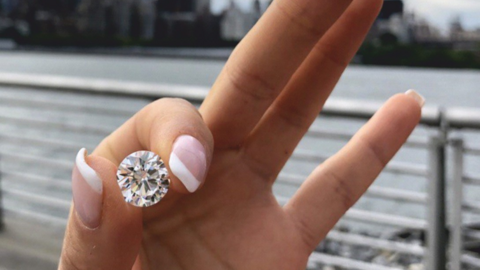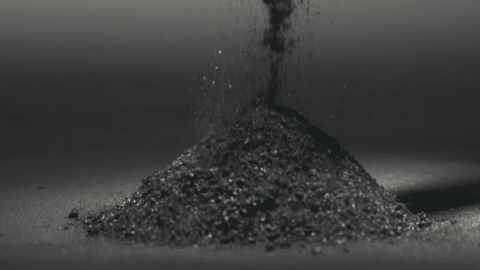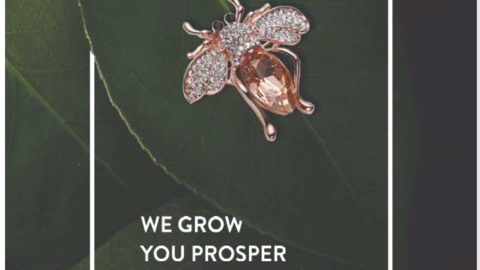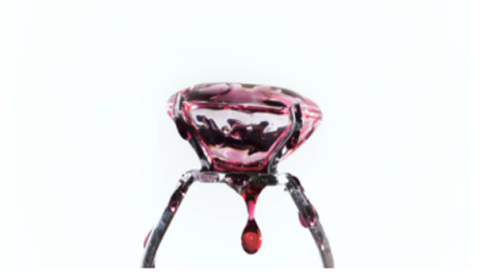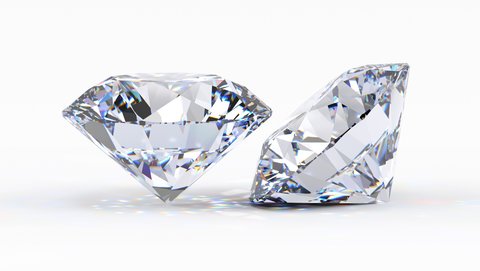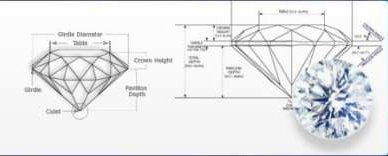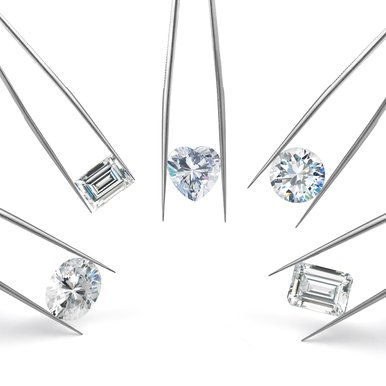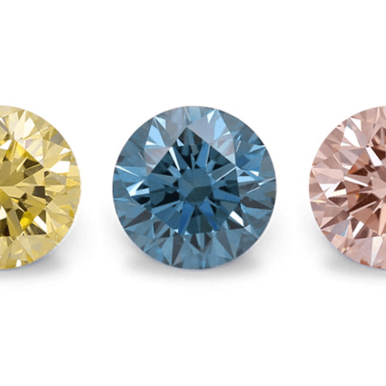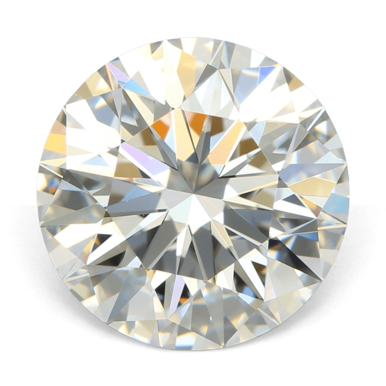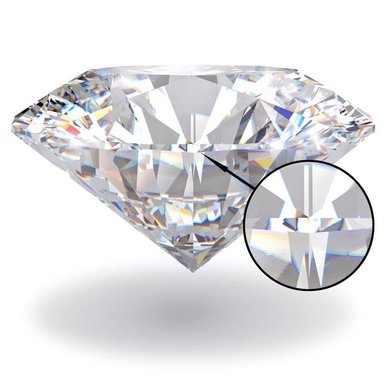Choosing Between Oval and Round Lab Grown Diamonds: A Complete Guide

When selecting the perfect lab grown diamond for your engagement ring or fine jewelry, shape is one of the most important decisions you'll make. Two of the most popular choices — round and oval diamonds — each offer distinct advantages and unique characteristics. Today, round diamonds account for approximately 75% of all diamond sales, while oval diamonds are experiencing impressive growth at a rate of 23% annually. Whether you prefer timeless elegance or trendy sophistication, this comprehensive guide from Labrilliante will help you make an informed decision between oval and round lab grown diamonds.
The Rich Heritage of Diamond Cuts
The round and oval diamonds we admire today have fascinating evolutionary journeys that span centuries. The round brilliant cut, the most popular diamond shape worldwide, traces its roots back to the 17th century when early diamond cutters began experimenting with facet patterns to maximize brilliance. Through centuries of refinement, master craftsmen gradually developed the 58-facet structure that defines today's round brilliant cut.
In contrast, the oval cut diamond is a relatively modern innovation. This elegant shape was formally introduced to the diamond world in 1957 by the renowned diamond cutter Lazare Kaplan. By adapting the round brilliant's faceting pattern into an elongated form, Kaplan created a cut that combines the traditional round's fire and brilliance with a distinctive elongated silhouette. Since its introduction, the oval cut has evolved through technological advancements in cutting techniques, becoming increasingly popular for those seeking a unique yet brilliant diamond option.
At Labrilliante, we honor these traditions while embracing cutting-edge technology to create lab grown diamonds that perfectly embody the best qualities of both these historic cuts.
The Anatomy of Shape: Comparing Physical Characteristics
Understanding the physical attributes of round and oval diamonds helps reveal why each shape creates such a distinctive visual impact. While both cuts are derived from similar faceting principles, their proportions and symmetry create markedly different appearances.
Round diamonds feature perfect symmetry with ideal proportions that have been mathematically calculated to maximize light performance. The standard round brilliant consists of 58 facets (or 57 if the culet is pointed), divided between the crown (top), girdle (middle), and pavilion (bottom). This perfect symmetry is why round diamonds are the only shape that receives a formal cut grade from gemological laboratories like GIA.
Oval diamonds typically maintain the same 58-facet structure as round brilliants but stretched into an elongated form. Their most distinctive measurement is the length-to-width ratio, which typically ranges from 1.3:1 to 1.7:1. The most popular oval proportions fall between 1.5:1 and 1.6:1, offering a balanced, pleasing shape. More elongated ovals (1.7:1 and above) create a dramatic, finger-lengthening effect, while shorter ovals (1.3:1 to 1.4:1) appear more rounded and substantial.
Oval vs Round Lab-Grown Diamonds: Technical Specifications
| Feature | Round Diamond | Oval Diamond |
|---|---|---|
| Facet Count | 58 (57 with pointed culet) | 57-58 |
| Symmetry | Perfect radial symmetry | Bilateral symmetry |
| Length-to-Width Ratio | 1:1 (perfect circle) | 1.3:1 to 1.7:1 (typical) |
| Cut Grade | GIA graded | No official grading system |
| Shape Variations | Minimal variation | Multiple proportion options |
| Typical Table % | 54-57% | 53-63% |
| Typical Depth % | 59-62.5% | 58-62% |
At Labrilliante, our master cutters optimize each lab grown diamond's proportions to achieve the ideal balance of brilliance and size appearance for both round and oval shapes.
Capturing Light: Brilliance and Sparkle Evaluation
When it comes to light performance, round and oval diamonds each have distinctive characteristics that influence their visual appeal. Understanding these differences is crucial when selecting the perfect lab grown diamond.
The Unmatched Brilliance of Round Diamonds
Round brilliant diamonds are engineered for optimal light performance. Their perfectly symmetrical design with precisely calculated facet angles allows them to capture and return light with maximum efficiency. This is why round diamonds consistently deliver superior brilliance—that bright white light that flashes when a diamond moves—and exceptional fire (the colored light dispersion). The standardized cut grading system developed by gemological laboratories provides clear guidelines for round diamonds, making it easier to identify specimens with exceptional light performance.
The Unique Light Play of Oval Diamonds
Oval diamonds offer a different but equally captivating light pattern. Their elongated shape creates a larger surface area, which can produce impressive flashes of light. However, due to their elongated proportions, ovals typically display a slightly different pattern of light return compared to rounds. One characteristic unique to oval diamonds is the "bow-tie effect"—a dark shadow that can appear across the center of the stone when viewed from certain angles. This effect varies significantly in intensity:
- Minimal bow-tie: Almost imperceptible, allowing for exceptional brilliance throughout
- Moderate bow-tie: Creates an interesting contrast that many find appealing
- Pronounced bow-tie: May detract from the overall brilliance of the diamond
At Labrilliante, our expert gemologists carefully select lab grown oval diamonds that minimize this effect while maximizing brilliance. Unlike round diamonds, oval cuts don't receive official cut grades from most gemological laboratories, making it essential to purchase from a reputable source with strict quality standards.

Creating Maximum Impact: Size Perception and Visual Appeal
When comparing oval and round diamonds of equal carat weight, there's a significant difference in their visual impact. This perception factor is often crucial when selecting the perfect lab grown diamond for your budget.
The Size Advantage of Oval Diamonds
Oval diamonds typically appear approximately 10% larger than round diamonds of the same carat weight. This size advantage occurs because oval diamonds distribute their weight across a larger surface area, creating a greater face-up appearance. For example, a 1-carat oval diamond might appear similar in size to a 1.1-carat round diamond, potentially allowing you to choose a lower carat weight while maintaining impressive visual presence.
This size illusion makes oval diamonds an excellent choice for maximizing visual impact within your budget at Labrilliante. The elongated shape also creates a flattering effect on the hand, making fingers appear longer and more slender—a aesthetic bonus that many wearers appreciate.
The Visual Impact of Round Diamonds
While round diamonds may appear slightly smaller carat-for-carat, they compensate with unparalleled brilliance. Their perfectly symmetrical shape creates a concentrated sparkle that draws attention regardless of size. The round shape also creates a timeless, balanced appearance on the finger that complements any hand shape or size.
Additionally, round diamonds' even proportions make them extremely versatile when paired with different setting styles. Their circular outline allows them to sit beautifully in traditional pronged settings, modern bezel settings, or intricate vintage-inspired designs.
The 4Cs Masterclass: Evaluating Quality Factors
The famous 4Cs—cut, color, clarity, and carat weight—take on different characteristics when comparing oval and round lab grown diamonds. Understanding these differences is essential for making an informed purchase at Labrilliante.
Cut: The Most Crucial Quality Factor
For round diamonds, cut quality is standardized and precisely graded by gemological laboratories. The ideal proportions are well-established, making it relatively straightforward to identify a well-cut round diamond by reviewing its cut grade (Excellent, Very Good, Good, etc.).
Oval diamonds present a more nuanced evaluation since they don't receive official cut grades. The quality assessment depends on several factors:
- Balanced proportions with minimal asymmetry
- Proper facet alignment
- Minimized bow-tie effect
- Pleasing length-to-width ratio
At Labrilliante, our gemologists rigorously assess each oval diamond against strict internal standards to ensure exceptional light performance and beauty.
Color: Visibility Differences
Color is perceived differently in round versus oval diamonds. The round brilliant's faceting pattern tends to hide slight coloration, making it more forgiving. This means a round diamond might appear colorless even with a slightly lower color grade.
Oval diamonds, however, tend to show color more readily, particularly in their elongated edges. When shopping for an oval diamond, you may want to select a color grade approximately 1-2 grades higher than you would for a round diamond to achieve a similar colorless appearance. For example, if you'd be satisfied with an F color in a round, you might prefer a E or D color in an oval.
Clarity: Inclusion Visibility
Round diamonds excel at masking inclusions due to their brilliant faceting pattern, which breaks up and disperses light, making small imperfections less visible. By contrast, oval diamonds—particularly those with larger open facets—may make inclusions more noticeable.
When selecting an oval diamond, paying closer attention to the location and nature of inclusions becomes more important. A strategically placed inclusion near the girdle might be completely hidden by a prong setting, while even a small inclusion in the center might be more visible.
Carat Weight: Value Proposition
As mentioned earlier, oval diamonds appear larger than round diamonds of equal carat weight. This creates an interesting value proposition: you can either select a smaller carat weight oval diamond to achieve the same visual impact as a larger round diamond (saving money), or you can maximize the impressive appearance by choosing an oval diamond of the same carat weight as you would a round.
Investment Considerations: Understanding Diamond Pricing
The price difference between round and oval lab grown diamonds is significant and worth understanding before making your purchase decision at Labrilliante.
The Premium for Round Diamonds
Round diamonds typically command a price premium of 25-28% over oval diamonds of comparable quality. Several factors contribute to this price difference:
- Cutting waste: Creating a round diamond typically results in more rough diamond material being lost during the cutting process
- Manufacturing complexity: The precise symmetry required for an ideal round cut demands exceptional skill and precision
- Market demand: As the most popular shape, round diamonds maintain consistently high demand
- Standardized grading: The established cut grading system for rounds creates clear price distinctions
This substantial price difference means that at the same budget, you can typically purchase a significantly larger oval diamond than round, potentially up to 25% larger in carat weight.
Value Optimization with Oval Diamonds
Oval diamonds offer exceptional value for several reasons:
- More efficient cutting from rough crystal, resulting in less material waste
- Larger face-up appearance per carat compared to round cuts
- Growing popularity that hasn't yet reached the premium pricing of rounds
- Unique, distinctive appearance that stands out from traditional choices
At Labrilliante, we price our lab grown diamonds based on their intrinsic quality factors rather than artificial market manipulations, ensuring you receive exceptional value regardless of which shape you select.
Price Comparison: Round vs Oval Lab-Grown Diamonds
| Quality Level | 1ct Round Diamond | 1ct Oval Diamond | Approximate Savings |
|---|---|---|---|
| Premium | $3,500 | $2,650 | $850 (24%) |
| Excellent | $3,200 | $2,400 | $800 (25%) |
| Very Good | $2,900 | $2,150 | $750 (26%) |
| Good | $2,600 | $1,950 | $650 (25%) |
*Note: Prices are approximate and will vary based on specific quality characteristics of individual diamonds.
Setting the Stage: Style and Design Considerations
The diamond shape you choose significantly influences the overall aesthetic of your jewelry piece. Both round and oval lab grown diamonds from Labrilliante offer versatile design possibilities, but each shape creates a distinct style statement.

Setting Styles for Round Diamonds
Round diamonds remain the most versatile choice for a wide range of settings:
- Solitaire settings: The classic choice that allows maximum light to enter the diamond, showcasing its brilliance. Particularly stunning with 4-6 prongs that provide security while maintaining visibility.
- Halo settings: A circle of smaller diamonds surrounding the center stone creates the illusion of a larger diamond while adding additional sparkle.
- Three-stone settings: Symbolizing past, present, and future, these settings work beautifully with round diamonds of equal or graduated sizes.
- Pavé settings: Small diamonds set closely together along the band complement the round center stone's brilliance.
- Bezel settings: A metal rim surrounds the diamond completely, offering protection while creating a sleek, modern look.

Setting Styles for Oval Diamonds
Oval diamonds create distinctive looks in various settings:
- North-South orientation: The traditional vertical placement elongates the finger and creates a classic appearance.
- East-West orientation: A horizontal placement offers a contemporary, fashion-forward look that stands out from traditional designs.
- Halo settings: Particularly flattering for oval diamonds, as they enhance the already larger appearance and minimize any bow-tie effect.
- Three-stone settings: Oval side stones can create a cohesive, flowing design when paired with an oval center stone.
- Split-shank settings: The divided band draws attention to the center stone while complementing the oval's graceful curves.
Metal Pairings
Both diamond shapes work beautifully with various metals, though certain pairings enhance their natural characteristics:
- White gold/platinum: Creates a clean, modern look that emphasizes the diamond's brilliance; particularly flattering for both shapes.
- Yellow gold: Provides warm contrast against the diamond; can make lower color grade ovals appear slightly warmer.
- Rose gold: Offers romantic, vintage appeal; complements the elegant curves of oval diamonds especially well.
Vintage vs. Modern Aesthetics
Round diamonds effortlessly bridge both vintage and contemporary styles. Their timeless shape has remained consistently popular for centuries, making them appropriate for authentically vintage-inspired designs as well as clean, modern settings.
Oval diamonds, while having a rich history, carry a more contemporary feel in today's market. Their current popularity in celebrity engagement rings has positioned them as fashion-forward choices that still maintain elegance and sophistication.
Making the Right Choice: Advantages and Considerations
When deciding between round and oval lab grown diamonds, understanding the specific benefits and potential drawbacks of each shape will help you make a decision that aligns with your preferences, lifestyle, and budget. At Labrilliante, we believe in providing comprehensive information to ensure your complete satisfaction.
Comparison: Round vs Oval Diamonds
| Feature | Round Diamonds | Oval Diamonds |
|---|---|---|
| Brilliance | Maximum brilliance with mathematically optimized proportions | Very good brilliance, though not as intense as round |
| Visual Size | Smaller appearance for same carat weight | Appears approximately 10% larger than rounds of equal carat |
| Price | 25-28% higher cost than oval of equivalent quality | More affordable, allowing for larger or higher-quality stone |
| Appeal | Timeless, classic, never goes out of style | Modern, currently trending in celebrity and fashion circles |
| Distinctiveness | Most common diamond shape | Less common, offers a more unique choice |
| Quality Assessment | Standardized cut grading system | Less standardized, requires more expertise |
| Inclusion Masking | Brilliant faceting effectively hides minor inclusions | Can show inclusions more readily |
| Color Sensitivity | Less color visible due to faceting pattern | Shows color more readily, may require higher color grade |
| Finger Effect | No elongating effect on finger | Creates slimming, elongating appearance on finger |
| Special Considerations | None | Bow-tie effect; vulnerability at points requiring protection |
| Setting Versatility | Complements virtually any setting style or design | Some setting limitations; certain styles work better |

Finding Your Perfect Match: Selection Criteria for Diamond Shapes
With a clear understanding of the differences between round and oval lab grown diamonds, it's time to consider which shape aligns best with your personal preferences and practical considerations. At Labrilliante, we recommend evaluating these key factors when making your decision.
Personal Style Assessment
Your personal aesthetic preferences should be the primary consideration:
- Classic or contemporary: Round diamonds offer timeless appeal, while ovals provide a modern yet elegant alternative. Consider whether you prefer traditional styles that stand the test of time or more distinctive, fashion-forward designs.
- Understated or statement-making: Round diamonds blend harmoniously into most settings, while oval shapes naturally draw more attention due to their distinctive elongated form.
- Versatility needs: Consider how well the shape will coordinate with your existing jewelry collection and whether you might want to reset the diamond in different styles throughout your lifetime.
Hand and Finger Considerations
The shape of your hands and length of your fingers can influence which diamond shape appears most flattering:
- Shorter fingers: Oval diamonds create an elongating illusion that can make fingers appear longer and more slender.
- Wider hands: The length of oval diamonds can provide a balancing contrast to wider hands.
- Long, slender fingers: Round diamonds offer proportion and balance for naturally long fingers.
- Average proportions: Both shapes work beautifully on balanced hand proportions.
Try on different shapes whenever possible before making your final decision, as the interaction between diamond shape and your unique hand characteristics is highly personal.
Lifestyle Factors
Your daily activities and lifestyle should influence your diamond shape selection:
- Active lifestyle: Round diamonds have no points or edges that can catch on clothing or objects, making them slightly more practical for very active individuals.
- Professional considerations: Both shapes are workplace-appropriate, though rounds may offer a more understated professional appearance in conservative environments.
- Maintenance preferences: Round diamonds generally require less frequent cleaning as they trap less debris beneath the stone.
Budget Optimization
Maximize value within your budget by considering these factors:
- Size priority: If a larger-looking diamond is your priority, an oval will provide approximately 10% more visible diamond per carat.
- Quality priority: If exceptional brilliance is your priority, you might prefer investing in a higher-quality, slightly smaller round diamond.
- Setting costs: Consider that certain setting styles may cost more for oval diamonds due to their specialized proportions.
Setting and Design Preferences
Your preferred setting style may naturally complement one shape over the other:
- Solitaire lovers: Both shapes excel in solitaire settings, with rounds offering classic elegance and ovals providing modern sophistication.
- Halo enthusiasm: Oval halos create dramatic finger coverage, while round halos offer perfectly balanced symmetry.
- Vintage inspiration: Round diamonds pair authentically with true vintage settings, while ovals can provide a fresh twist on antique designs.
Diamond Shape Trends: Celebrity Influences and Market Movements
The popularity of diamond shapes evolves with fashion trends, celebrity choices, and changing consumer preferences. Understanding current market trends can provide additional context for your decision between round and oval lab grown diamonds at Labrilliante.
Current Market Trends
While round diamonds maintain their position as the most popular shape (accounting for approximately 75% of all diamond sales), oval diamonds have experienced remarkable growth in recent years. This upward trajectory reflects changing consumer preferences toward more distinctive, individual expressions in engagement rings and fine jewelry.
Several factors contribute to the rising popularity of oval diamonds:
- Greater value consciousness among consumers
- Desire for unique yet timeless jewelry pieces
- Increasing awareness of fancy diamond shapes
- Social media influence showcasing diverse diamond options
Notable Celebrity Oval Diamond Rings
Celebrities have played a significant role in popularizing oval diamonds through their highly publicized engagement rings:
- Blake Lively's 12-carat oval diamond set in rose gold, given to her by Ryan Reynolds
- Hailey Bieber's substantial oval diamond on a simple gold band from Justin Bieber
- Kourtney Kardashian's oval diamond engagement ring from Travis Barker
- Serena Williams' large oval diamond set in a minimalist design
These high-profile oval diamond rings have attracted considerable attention and influenced engagement ring trends across the jewelry market.
Celebrated Round Diamond Rings
Round diamonds continue to be favored by many celebrities who appreciate their classic appeal:
- Michelle Obama's round diamond engagement ring from Barack Obama
- Felicity Jones' vintage-inspired round diamond ring
- Miranda Kerr's classic round diamond solitaire from Evan Spiegel
- Kate Middleton's sapphire and round diamond halo ring (formerly Princess Diana's)
Social Media and Digital Influence
Social platforms have significantly impacted diamond shape preferences:
- Pinterest boards showcasing unique oval diamond designs
- Instagram influencers highlighting the finger-flattering effects of oval shapes
- Wedding websites featuring both traditional round and trending oval options
- TikTok videos comparing the sparkle and size appearance of different shapes
At Labrilliante, we track these trends while recognizing that the perfect diamond shape is ultimately a personal choice that transcends temporary fashion movements.
Making Your Lab Grown Diamond Decision: Expert Guidance
After examining all aspects of round and oval lab grown diamonds, the decision ultimately depends on your personal priorities and preferences. At Labrilliante, we help customers find their perfect diamond match by focusing on these essential factors.
Key Differences at a Glance
Round and oval diamonds each offer distinct advantages:
- Brilliance profile: Round diamonds provide maximum brilliance with their mathematically optimized faceting pattern, while oval diamonds offer an elongated sparkle with their extended shape.
- Visual size: Oval diamonds appear approximately 10% larger than round diamonds of the same carat weight.
- Price consideration: Round diamonds typically cost 25-28% more than comparable oval diamonds.
- Aesthetic impact: Round diamonds create a timeless, classic look, while oval diamonds offer a contemporary yet elegant alternative.
- Hand enhancement: Oval diamonds create a slimming, elongating effect on fingers that round diamonds don't provide.
Decision Framework
To determine which shape is right for you, consider prioritizing these factors in order of personal importance:
- Budget allocation: How important is maximizing carat weight vs. other quality factors?
- Style preference: Does your personal aesthetic lean traditional or contemporary?
- Hand flattery: Which shape complements your hand shape and finger length?
- Visual priorities: Do you value maximum brilliance or larger perceived size?
- Setting vision: Which diamond shape best suits your preferred jewelry setting?
Future-Proofing Your Choice
While both shapes have enduring appeal, they carry different considerations for long-term satisfaction:
- Round diamonds have maintained consistent popularity for centuries, making them a safe choice for lifelong wear.
- Oval diamonds have experienced cyclical popularity but have now established themselves as a contemporary classic rather than a passing trend.
At Labrilliante, all our lab grown diamonds are certified and graded by reputable gemological laboratories, ensuring that whichever shape you choose, you receive exceptional quality and value that will stand the test of time.
Decision Matrix: Round vs Oval Lab-Grown Diamonds
| Priority | Choose Round If... | Choose Oval If... |
|---|---|---|
| Budget How important is carat weight vs. quality? | You prioritize optimal cut and maximum brilliance over size | You want to maximize carat size for your budget (25-28% savings) |
| Style Preference Traditional or contemporary? | You prefer timeless, classic designs that never go out of style | You prefer contemporary, distinctive styles with modern appeal |
| Hand Flattery Which shape complements your hand? | You have longer fingers or don't need visual elongation effect | You want a slimming, elongating effect on your fingers |
| Visual Priority Brilliance vs. perceived size? | You value maximum brilliance and fire over perceived size | You prefer larger appearance (10% larger than round at same carat) |
| Both shapes offer enduring appeal and exceptional quality when certified by reputable laboratories | ||
Other diamond shapes
Frequently Asked Questions About Oval vs Round Lab Grown Diamonds
An oval diamond appears approximately 10% larger than a round diamond of identical carat weight. This size advantage occurs because oval diamonds distribute their weight across a larger surface area, creating a more substantial face-up appearance while maintaining the same actual weight.
The bow-tie effect is a dark shadow that appears across the center of an oval diamond when viewed from certain angles. While it cannot be completely eliminated in most cases, the effect can be minimized through expert cutting. At Labrilliante, we carefully select oval diamonds with minimal bow-tie impact to ensure maximum brilliance throughout the stone.
Round diamonds are typically 25-28% more expensive than oval diamonds of comparable quality and carat weight. This price premium exists because round diamonds require more rough material during cutting, demand more precise manufacturing, and maintain consistently higher market demand due to their popularity.
Yes, particularly with oval diamonds. When set in the traditional north-south (vertical) orientation, oval diamonds create a lengthening effect on the finger. However, when placed in an east-west (horizontal) orientation, they create a bold, contemporary look that appears completely different while using the exact same stone. Round diamonds, being perfectly symmetrical, don't offer this versatility.
Yes. Round diamonds are more forgiving of inclusions because their brilliant faceting pattern effectively disperses and hides small imperfections. Oval diamonds, especially those with larger open facets, tend to show inclusions more readily. At Labrilliante, we typically recommend at least VS1 clarity for oval diamonds, while VS2 clarity may be acceptable for round diamonds of similar size.
Lab grown diamonds from Labrilliante have identical physical, chemical, and optical properties to mined diamonds in both round and oval shapes. The primary differences are ethical sourcing, environmental impact, and price—lab grown diamonds typically cost 30-40% less than mined diamonds of equivalent quality, regardless of shape.
Round diamonds typically maintain stronger resale value due to their consistent market demand and standardized qualities. However, all diamonds—including both round and oval shapes—should be viewed primarily as emotional investments rather than financial ones. At Labrilliante, our lab grown diamonds offer exceptional initial value, allowing you to invest in higher quality or larger size for the same budget.
Absolutely. Hand size, finger length, and even knuckle prominence can dramatically influence how a diamond shape appears when worn. Oval diamonds visually elongate shorter fingers and balance wider hands, while round diamonds provide proportion to very long, slender fingers. Taking hand photos while trying on different shapes provides the most accurate preview of how each shape will look on your unique hand.


